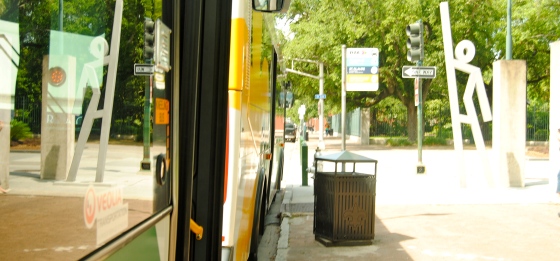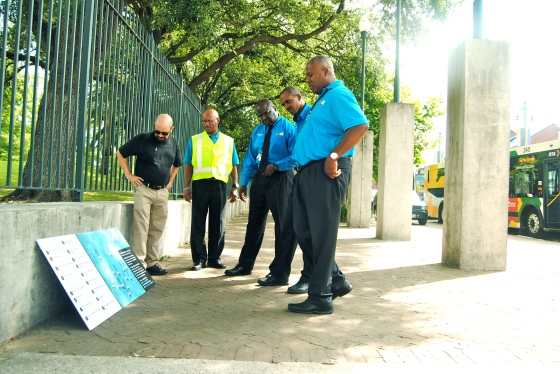New Orleans, Louisiana
June 27-28, 2013
As we drive down North Rampart Street in New Orleans, we pass a fourteen-foot tall, steel statue of a person with one arm outstretched as if to hail a ride. Its pose seems symbolic as much as aesthetic, drawing people to it as if to say, “stick with me and I will guide you.” And that’s exactly what the statue does, because it marks an ‘EvacuSpot.’
Art will show the way
‘Evacuspots’ now replace the nondescript evacuation signs that previously marked meeting points to catch buses out of New Orleans during an emergency. When Mayor Mitch Landrieu issues the next mandatory evacuation, ideally New Orleanians will automatically know where to go. Evacuteer, a non-profit created in 2009 that now partners with the City on emergency management, had the idea to use public art to help people remember.
“I think the cornerstone of resilience is finding ways to bring communities together at large. Public art sculptures do this,” David Morris, the President of Evacuteer’s Executive Leadership Committee told us. “It’s a novel approach to emergency management.”
Evacuteer partnered with the Arts Council of New Orleans to hold a contest for the best public art design for the evacuation meeting points. Artist Douglas Kornfeld had the winning submission.
“I thought to myself, what do you do when you’re trying to catch a ride? You don’t just stand there, you lift up your arm to get the attention of a driver. It’s almost instinctual—a universal gesture,” Kornfeld told us.

Douglas Kornfeld (left) does the Evacuteer pose with New Orleans Regional Transit Authority bus drivers who will be responsible for picking people up at EvacuSpots during an emergency evacuation.
Fifteen of the 17 statues are already in the ground around the City—four located near senior centers and the rest at important public access points. If there is a mandatory evacuation, people (and their pets) who have no other means to leave the city can meet at an EvacuSpot where a city bus will take them to the Union Passenger Terminal. From there, they’ll catch another bus out of town.
Non-evacuation is a non-option
Before Hurricane Katrina hit in 2005, New Orleans’ emergency management strategy consisted of trying to keep people safe in the city. After the tragic storm, which likely killed more than the 1,464 people in the official State death toll and displaced countless others, it was glaringly apparent that the City’s emergency management strategy needed to change.
Morris, Joy Bruce, and Jenny Caldaza—three members of Evacuteer’s Executive Leadership Committee who we met in New Orleans (at an EvacuSpot)—each have their own reason for getting involved in the organization. But a common thread runs through their stories: Their personal experience during Katrina demonstrated that non-evacuation was not a viable option in the future.
Calzada, a New Orleans native and Evacuteer’s Communications Chair, didn’t leave when Katrina hit in 2005. She, her partner, and three family members found themselves on an upper floor of the Hilton Riverside in what locals called “vertical evacuation.” They had tried to get a room at the Princess Monaco Hotel, but none were available. Days later, Calzada heard a story about a family whose vehicles were stuck in the Princess Monaco garage after a wall collapsed. They were forced to join the mass evacuation to the Superdome football stadium, where thousands of people were held for days in overwhelming heat amidst human waste, sickness, and violence.
“I realized two things,” Calzada said. “First, we were lucky to get our vehicles out after the storm. Second, if we were not around, we have family members who don’t have reliable transportation to evacuate themselves and would have to rely on the city to get them out.”

From left: Joy Bruce, David Morris, and Jenny Calzada of Evacuteer with adaptation road tripper Allie Goldstein.
Morris and Bruce were both outside of New Orleans when the storm hit and, after several days, were able to watch footage of the damage on TV.
Morris’s reaction was visceral: “When I saw the people on rooftops, I was devastated. I couldn’t believe it was happening in my home.”
Bruce, the Development and Sustainability Committee Chair of Evacuteer, was watching the footage from her apartment in Baton Rogue with her father and younger sisters—with the knowledge that her mother was still in New Orleans. When Bruce finally got in touch with her mother (cell phones weren’t working for a while), she found out she had been in the Superdome. In the meantime, Bruce’s father fell ill and had to be rushed to the Baton Rouge emergency room, where hundreds of injured had been taken because the New Orleans hospitals were powerless. Over thirteen hours, Bruce saw people who had broken bones from jumping off rooftops, people with blistering sunburns and heat stroke from being outside for days, and one person waiting for his half-complete surgery to be finished.
From vertical to actual evacuation
Hurricanes and Tropical Storms hit New Orleans and other coastal Louisiana communities regularly. In the years since Katrina, Hurricanes Rita, Gustav, Ike, Ida, Lee, and Isaac are just some of the storms that have caused damage. Climate change models show that Louisiana can expect more frequent and more intense storms on its coasts. Add to that the fact that Louisiana’s coastal wetlands, which provide important protection against storm surges, are disappearing at a rate of one football field every 38 minutes due mostly to land subsidence (sinking) and some to sea level rise. Combine it all, and it’s clear that it’s not a matter of if the next big storm will hit, but when and how hard.

Storm-buffering wetlands in the Louisiana Bayou south of New Orleans are disappearing because the land is sinking and seas are rising.
After the disastrous response to Katrina, New Orleans shifted its emergency management approach to City Assisted Evacuation—meaning that rather than help people stay in the city, they would help people get out. When Hurricane Gustav hit in 2008, the City helped evacuate 18,000 people. But the process wasn’t smooth, and many residents weren’t sure where to go to catch the buses.
“There was a plan to evacuate people, but it was a plan on paper,” said Morris.
‘Evacuteers’ lead the way
That’s where Evacuteer came in—to turn the plan into an effective, well-run program before the next big evacuation. Created in 2009 by Robert Fogarty, the non-profit focused on two major challenges: making sure New Orleanians know where to go to evacuate and training volunteers—called ‘evacuteers’—to help them get out.
Anyone can sign up to be an evacuteer. As of our meeting, the group had trained 200 volunteers for the 2013 hurricane season and plans to train 300 more by the season peak in mid-August. The organization targets volunteers between the ages of 18 and 35, a demographic that is often more available to help in a crisis. Evacuteers train to man 311 call centers during storms, organize evacuees at EvacuSpots, and direct bus passengers once they arrive at the Union Terminal. The group works closely with New Orleans’ Office of Homeland Security and Emergency Preparedness to ensure their volunteer trainings are up to snuff.
“We’ve started offering leadership opportunities for really committed evacuteers. In order to make the organization sustainable, it’s important to create a sense of ownership among the volunteers,” said Bruce. She recently helped secure a contract with the City that will help fund volunteer trainings.
Though (thankfully) a mandatory evacuation has not been called since the group was established, evacuteers did help with 311 calls during Hurricane Isaac in the fall of 2012.
“We’re constantly planning for this thing we hope we never have to use,” said Morris.
Still, when the next storm hits, hundreds of evacuteers will be ready. Somewhere between 30,000 and 50,000 New Orleans residents will meet at the glistening statues to hail their bus out of the City. And in the truest measure of resilience, after the storm the buses will bring passengers back to the very same statue they departed from, where it will still be standing with its arm outstretched in a gesture of strength and hope.

Evacuteer informational materials define an EvacuSpot as the following:
1) The official meeting places where anyone can go for a safe ride if the Mayor of New Orleans must call a mandatory evacuation.
2) The exact same places residents will have a ride back to once the City is safe and re-entry begins.







Pingback: The Many Small Ways Americans Are Adapting to Climate Change | TokNok Multi Social Blogging Solutions
Pingback: Adaptation – Volume 3 – Little Things | Transition Town Payson
Pingback: The UN’s New Focus: Surviving, Not Stopping, Climate Change | Radio Free